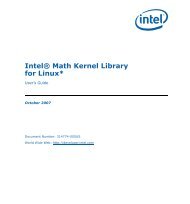Notes on pseudopotential generation
Notes on pseudopotential generation
Notes on pseudopotential generation
You also want an ePaper? Increase the reach of your titles
YUMPU automatically turns print PDFs into web optimized ePapers that Google loves.
A.2 Fully relativistic case<br />
The relativistic KS equati<strong>on</strong>s are Dirac-like equati<strong>on</strong>s for a spinor with a “large” R nlj (r)<br />
and a “small” S nlj (r) comp<strong>on</strong>ent:<br />
( d<br />
dr + κ )<br />
r<br />
c<br />
c<br />
( d<br />
dr − κ r<br />
)<br />
R nlj (r) = ( 2mc 2 − V (r) + ɛ ) S nlj (r) (9)<br />
S nlj (r) = (V (r) + ɛ) R nlj (r) (10)<br />
where j is the total angular momentum (j = 1/2 if l = 0, j = l+1/2, l−1/2 otherwise);<br />
κ = −2(j − l)(j + 1/2) is the Dirac quantum number (κ = −1 is l = 0, κ = −l − 1, l<br />
otherwise); and the charge density is given by<br />
n(r) = ∑ nlj<br />
A.3 Scalar-relativistic case<br />
Θ nlj<br />
R 2 nlj(r) + S 2 nlj(r)<br />
4πr 2 . (11)<br />
The full relativistic KS equati<strong>on</strong>s is be transformed into an equati<strong>on</strong> for the large<br />
comp<strong>on</strong>ent <strong>on</strong>ly and averaged over spin-orbit comp<strong>on</strong>ents. In atomic units (Rydberg:<br />
¯h = 1, m = 1/2, e 2 = 2):<br />
( )<br />
− d2 R nl (r) l(l + 1)<br />
+ + M(r) (V (r) − ɛ) R<br />
dr 2 r 2 nl (r)<br />
(<br />
−<br />
α2 dV (r) dRnl (r)<br />
+ 〈κ〉 R )<br />
nl(r)<br />
= 0, (12)<br />
4M(r) dr dr r<br />
where α = 1/137.036 is the fine-structure c<strong>on</strong>stant, 〈κ〉 = −1 is the degeneracyweighted<br />
average value of the Dirac’s κ for the two spin-orbit-split levels, M(r) is<br />
defined as<br />
M(r) = 1 − α2<br />
(V (r) − ɛ) . (13)<br />
4<br />
The charge density is defined as in the n<strong>on</strong>relativistic case:<br />
A.4 Numerical soluti<strong>on</strong><br />
n(r) = ∑ nl<br />
Θ nl<br />
R 2 nl(r)<br />
4πr 2 . (14)<br />
The radial (scalar-relativistic) KS equati<strong>on</strong> is integrated <strong>on</strong> a radial grid. It is c<strong>on</strong>venient<br />
to have a denser grid close to the nucleus and a coarser <strong>on</strong>e far away. Traditi<strong>on</strong>ally<br />
a logarithmic grid is used: r i = r 0 exp(i∆x). With this grid, <strong>on</strong>e has<br />
and<br />
df(r)<br />
dr<br />
= 1 r<br />
∫ ∞<br />
0<br />
df(x)<br />
dx ,<br />
f(r)dr =<br />
∫ ∞<br />
0<br />
d 2 f(r)<br />
dr 2<br />
f(x)r(x)dx (15)<br />
= − 1 r 2 df(x)<br />
dx<br />
+ 1 r 2 d 2 f(x)<br />
dx 2 . (16)








